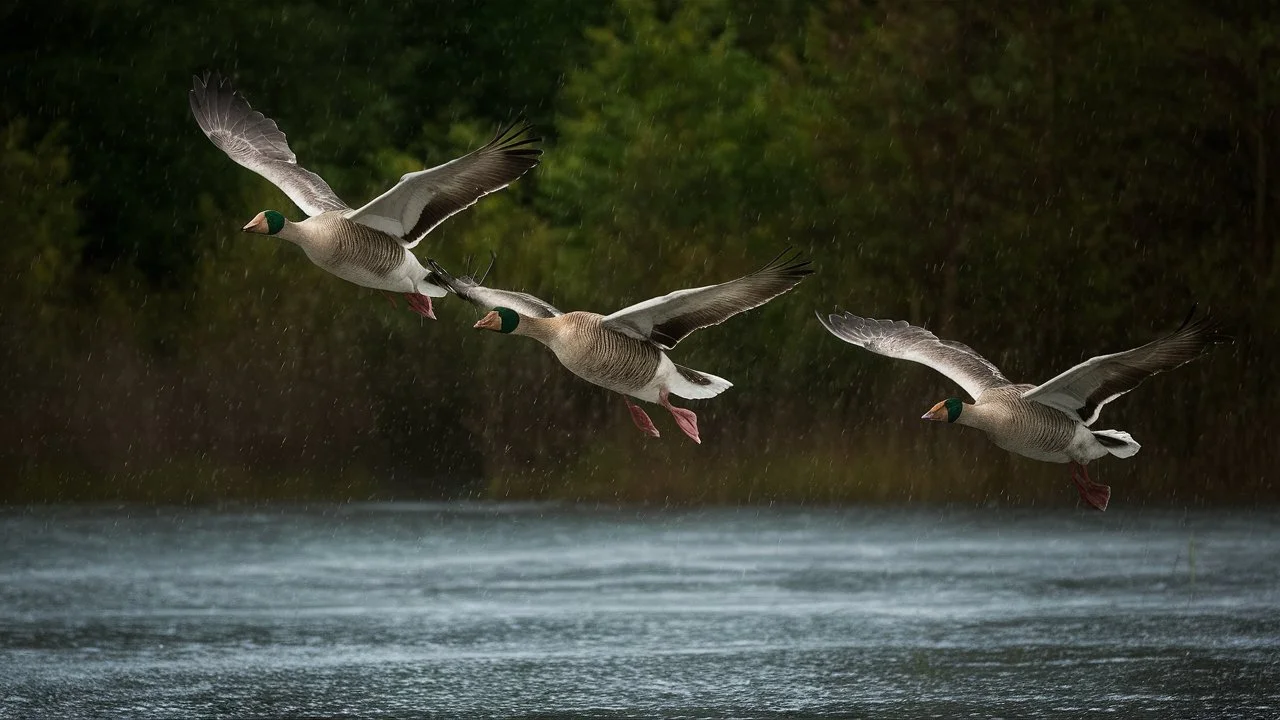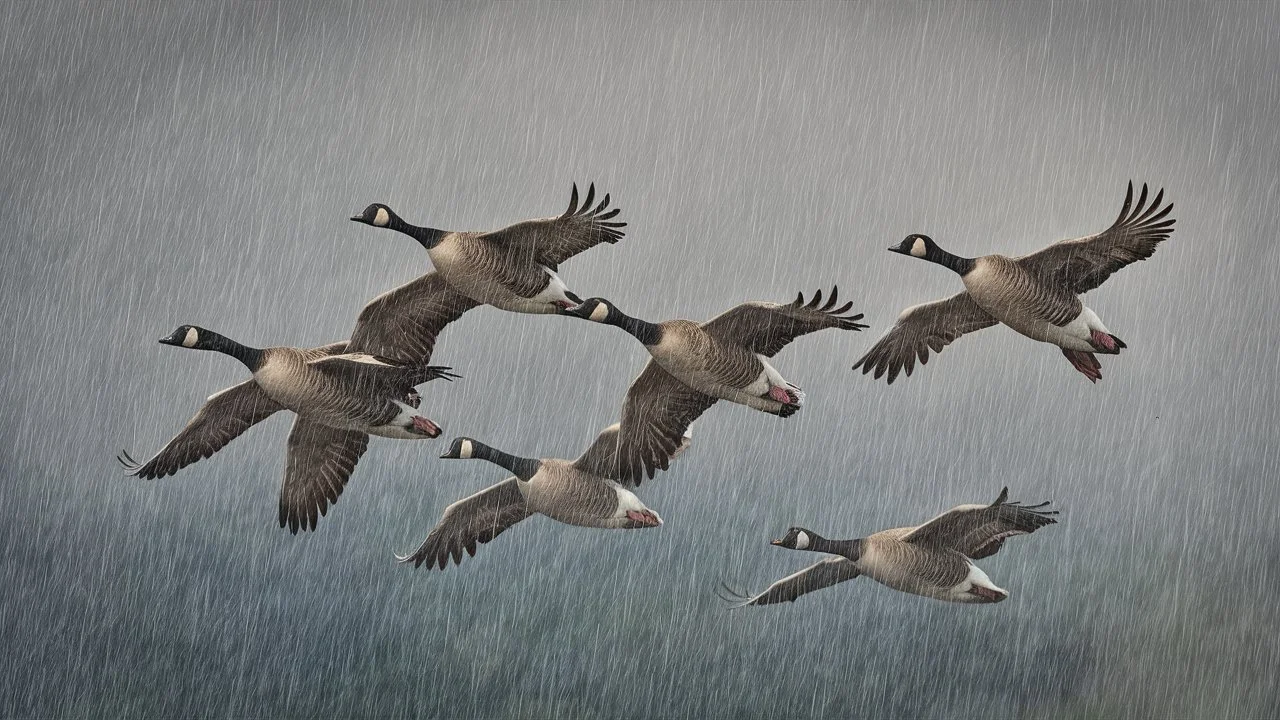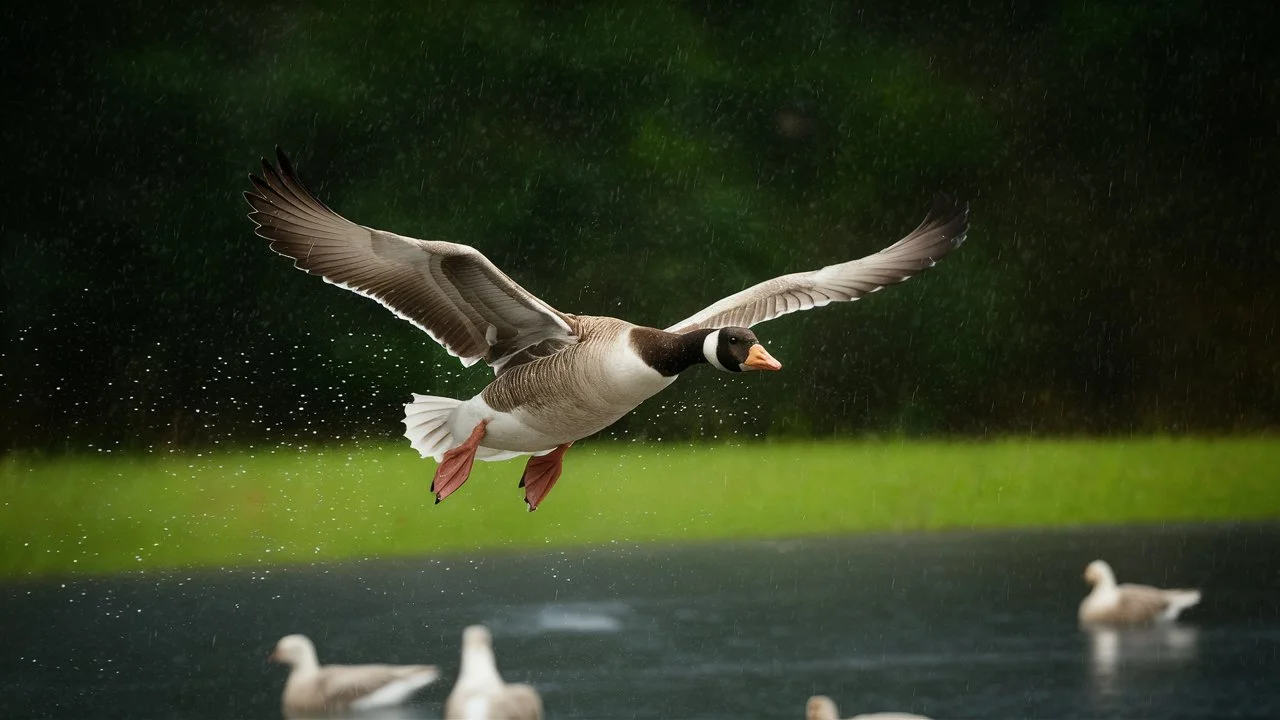Geese are fascinating birds that capture our attention with their loud honking and graceful flight patterns. Known for their impressive migratory journeys, these resilient birds can be seen flying in a distinctive “V” formation across vast distances. But what happens when the weather takes a turn for the worse? Have you ever wondered if geese fly in the rain?
Understanding how geese cope with rainy conditions can give us deeper insights into their behavior and adaptability. In this article, we will explore the factors that influence whether geese take to the skies during a downpour, how they navigate challenging weather, and the remarkable adaptations that enable them to thrive despite the elements.
Yes, geese can fly in the rain. However, whether they choose to do so depends on the intensity of the rain, wind conditions, and temperature. In light rain, geese often continue flying without much trouble, thanks to their waterproof feathers and strong wings. In heavier rain or strong winds, they may prefer to land and wait for better weather to conserve energy and stay safe.
Do Geese Fly in the Rain?
Geese are interesting birds that many people see in parks, lakes, and sometimes even flying in the sky. These birds are known for their loud honking sounds and their long journeys during migration. But have you ever wondered if geese fly in the rain?
Related reading: Do Ducks Fly at Night?
Let’s explore this question in simple terms.

Understanding Geese and Their Habits
First, let’s get to know geese a little better. Geese are large birds with long necks and strong wings. They are part of the bird family called “Anatidae,” which also includes ducks and swans. Geese are known for traveling in groups called flocks. They often form a “V” shape when flying together, which helps them save energy.
The Nature of Rain
Rain is water that falls from the sky in droplets. It can be light, like a drizzle, or heavy, like a downpour. Rain happens when clouds in the sky become full of water and release it. Just like humans, animals, and plants, rain affects geese too.
Can Geese Fly in the Rain?
The simple answer is yes, geese can fly in the rain. However, whether they choose to fly in the rain depends on several factors:
- Intensity of the Rain: If the rain is light, geese can fly without much trouble. Their strong wings and bodies can handle a little bit of rain. However, if the rain is very heavy, it can make flying difficult. Heavy rain can make it hard for geese to see and can make their feathers wet and heavy.
- Wind Conditions: Wind often accompanies rain. Geese are very good at flying, even in windy conditions, but strong winds can be challenging. If the wind is too strong, geese might decide to stay on the ground until the weather improves.
- Temperature: Rain often brings cooler temperatures. Geese are well-adapted to cold weather, but if it becomes too cold and rainy, they might prefer to stay in a safe and warm place.
How Do Geese Deal with Rain?
Geese have some special features that help them deal with rain:
- Waterproof Feathers: Geese have oily feathers that repel water. This means that their feathers do not easily get wet. The oil helps keep their feathers dry and light, which is important for flying.
- Strong Wings: Geese have strong wings that can help them fly even in challenging weather. Their wings are built to handle different conditions, including rain.
- Group Behavior: When geese fly in a group, they help each other. Flying in a “V” shape allows them to reduce wind resistance and save energy. This formation can also help them navigate better in rainy weather.

What Do Geese Do When It Rains?
When it rains, geese have a few options:
- Keep Flying: If the rain is light and the wind is not too strong, geese might continue flying. Their waterproof feathers and strong wings help them handle light rain without much trouble.
- Land and Wait: If the rain is heavy or the wind is strong, geese might decide to land and wait for the weather to improve. They often find a safe place, like a field or a body of water, to rest until the rain stops.
- Find Shelter: Geese sometimes find shelter under trees or other structures to stay dry. They might huddle together to keep warm and protect themselves from the rain.
Geese Migration and Weather
Geese are migratory birds, which means they travel long distances during certain times of the year. Migration usually happens in spring and fall. During these times, geese fly to find better food sources and suitable breeding grounds. Weather plays a big role in migration. Geese prefer to migrate during good weather conditions. However, if they encounter rain during migration, they have to make decisions based on the factors we discussed.
Observing Geese in the Rain
If you ever get a chance to watch geese during the rain, you might notice some interesting behaviors. You might see them flying through light rain, landing to rest during heavy rain, or seeking shelter under trees. Watching geese can teach us a lot about how animals adapt to their environment.
How Long Do Geese Fly in the Rain?
Geese are remarkable birds known for their long migratory journeys and their ability to fly in various weather conditions, including rain. But how long do geese actually fly in the rain? Let’s explore this question in simple terms.
Factors Affecting Flight Duration in Rain
- Intensity of the Rain: The heaviness of the rain plays a significant role. In light rain, geese can continue flying for several hours, just as they would in dry weather. However, in heavy rain, the duration of their flight is likely to be shorter. Heavy rain can reduce visibility and make flying more challenging, leading geese to find a place to rest sooner.
- Wind Conditions: Rain is often accompanied by wind. While geese are strong fliers, strong winds can make flying difficult and tiring. If the wind is too strong, geese might reduce their flight time and look for a safe place to land.
- Temperature: Rain can bring cooler temperatures, which can affect how long geese can comfortably fly. If it gets too cold, they might prefer to land and conserve energy until the weather improves.
- Availability of Safe Resting Places: During their flight, geese need suitable places to land and rest. If they find a good spot, like a lake or a field, they might decide to stop sooner, especially if the rain is heavy or persistent.
Typical Flight Duration
In optimal conditions, geese can fly for many hours without stopping, sometimes covering hundreds of miles in a single day during migration. However, when it rains, their flight duration can vary:
- Light Rain: In light rain, geese might continue flying for several hours, similar to their flight in clear weather. Their waterproof feathers help them stay dry, and they can maintain their usual pace.
- Moderate to Heavy Rain: In moderate to heavy rain, geese are likely to reduce their flight time. They might fly for shorter periods, such as 1-2 hours, before looking for a place to rest. The need to find shelter and conserve energy becomes more important in these conditions.
Observing Geese in Rain
When observing geese in the rain, you might notice that they adjust their behavior based on the weather. In light rain, you could see them continuing their journey with minimal interruption. In heavier rain, they might descend to lower altitudes, land more frequently, and seek shelter.
Adaptations for Flying in Rain
Geese have several adaptations that help them fly in the rain:
- Waterproof Feathers: Their feathers contain natural oils that repel water, keeping them dry and light.
- Strong Wings: Their wings are powerful and capable of handling various weather conditions.
- Group Flight: Flying in a V-formation helps them reduce wind resistance and share the workload, making it easier to continue flying even in challenging weather.
Where Do Geese Go When It Storms?
Geese are adaptable and resilient birds, known for their ability to navigate long migratory journeys and varying weather conditions. When a storm approaches, geese need to find a safe place to wait it out. Let’s explore where geese go and how they behave during storms in simple terms.
Seeking Shelter
When a storm approaches, geese look for safe places to shelter. Here are some common places where geese might go during a storm:
- Lakes and Ponds: Geese often seek refuge on bodies of water. Lakes and ponds provide a safe haven where geese can float and stay away from predators. Water also offers some protection from the wind and rain.
- Fields and Open Spaces: Geese might land in open fields or grassy areas. These places provide enough space for the flock to stay together and rest. Geese prefer areas where they can see approaching danger and have a quick escape route.
- Trees and Shrubs: Although geese are not tree-dwelling birds, they might take shelter near trees and shrubs. These natural structures can provide some protection from the wind and rain.
- Man-made Structures: In urban or suburban areas, geese might use man-made structures for shelter. These can include buildings, bridges, or even large culverts. Such structures can offer protection from the elements.
Behavior During Storms
Geese exhibit certain behaviors when a storm is imminent or ongoing:
- Landing and Resting: As a storm approaches, geese usually land and rest. They conserve energy and avoid the dangers of flying in turbulent weather. By staying on the ground or water, they reduce the risk of being blown off course or injured by strong winds.
- Huddling Together: Geese often huddle together during a storm. This behavior helps them stay warm and provides some protection against the wind and rain. Staying in a group also allows them to keep an eye on each other and maintain a sense of security.
- Reduced Activity: During a storm, geese minimize their activity. They focus on staying safe and conserving energy. You might see them sitting quietly on the water or ground, waiting for the storm to pass.
Adaptations for Stormy Weather
Geese have several adaptations that help them cope with stormy weather:
- Strong Wings: Geese have strong wings that help them navigate through various weather conditions. However, during a severe storm, they prefer to avoid flying and instead find shelter.
- Waterproof Feathers: Their feathers are coated with natural oils that repel water. This helps them stay dry and warm even in heavy rain.
- Instinctive Behavior: Geese have strong instincts that guide them to safe places during storms. They can sense changes in the weather and respond accordingly.
Migration and Storms
During migration, geese cover long distances and encounter various weather conditions, including storms. When faced with a storm during migration, geese will:
- Land and Wait: If a storm occurs during migration, geese will land in a safe area and wait for the storm to pass. This might delay their journey, but it ensures their safety.
- Use Their Navigational Skills: Geese have excellent navigational skills. They can adjust their flight path to avoid the worst parts of a storm or find alternative routes.
Conclusion
In conclusion, geese can fly in the rain, but their decision to do so depends on the intensity of the rain, wind conditions, and temperature. Geese have special features like waterproof feathers and strong wings that help them handle rainy weather. When faced with heavy rain or strong winds, geese might choose to land and wait for better conditions. Understanding how geese deal with rain helps us appreciate these amazing birds even more. So, the next time it rains, take a moment to observe the geese around you and see how they manage in the wet weather.

